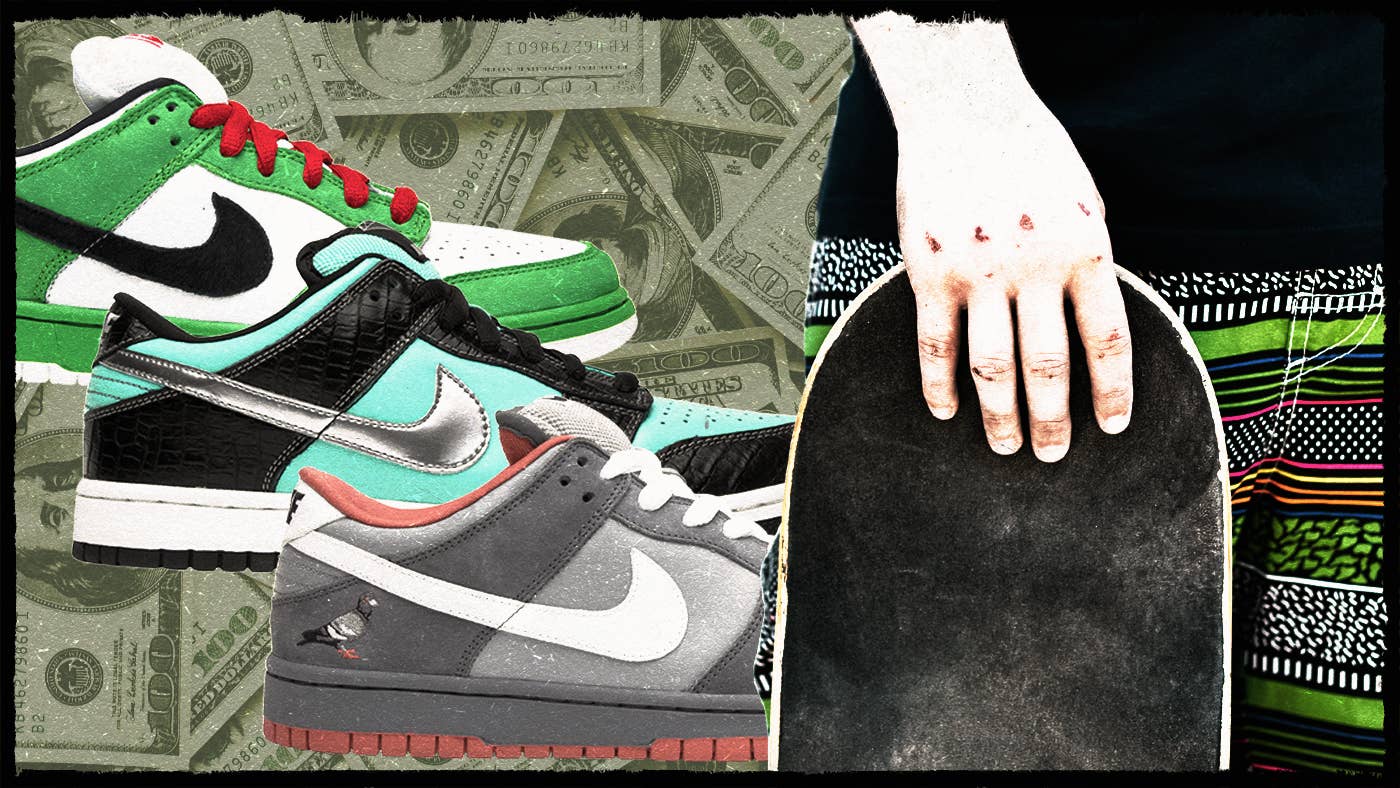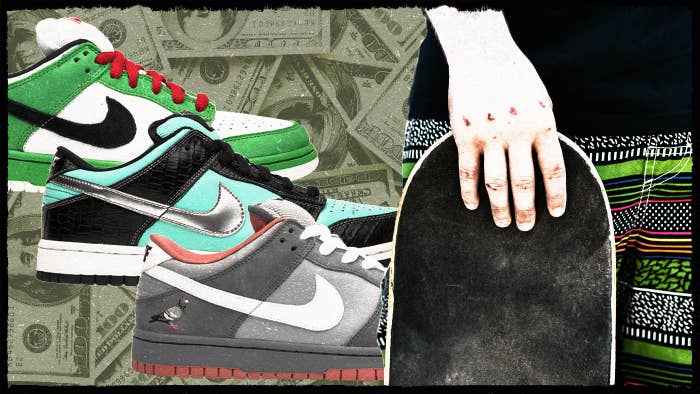
Demand is increasing, resell prices are skyrocketing, and Nike SB is having a moment right now, there's no doubt about it. After cooling down for much of the 2010s, Nike's skateboarding sub-label, which launched in 2002, has picked back up over the past few years thanks to collaborations with the likes of Ben & Jerry's and Travis Scott. The secondary market on SB products, especially those worn by the aforementioned artist, has ballooned, with pairs that went on sale when they first released now fetching over $1,000. What made Nike SBs different from other hyped sneakers at the time is that it was sold by actual core skate shops—stores that made their bones from decks and hardgoods had to transition to catering to sneaker-driven hypebeasts. It's a difficult enough task for major brands to deal with, let alone skate shops.
Getting Nike into skateboarding was a much harder than people would think. The Air Jordan 1 was originally worn by skaters such as Tony Hawk and Lance Mountain in the 1980s, but the brand's corporate, jock-driven energy was everything that skateboarding wasn't. Skaters wanted to support skater-owned footwear brands, such as éS and DC, rather than sportswear monoliths with infinite cash. Nike made a run at skating in the '90s, with awfully named shoes such as the Choad and the backing of skaters like Bam Margera, but it didn't stick. That all changed when longtime employee Sandy Bodekcer founded SB in the early 2000s. He immersed himself in that world, corralled skaters such as Reese Forbes, Gino Iannucci, Richard Mulder, and Danny Supa to wear and give credibility to the product, and centered it all around a shoe with genuine Nike lineage: the Dunk, which first released in 1985.
“I was like, ‘Oh, shit. This is tight. They’re actually making Dunks for skateboarding,” says rapper and skater Reese LaFlare. “I was already skating in Dunks, Ultra Mans. I fucked with it.”
The shoes were inspired by themes that made sense to skaters, like a pair of Nikes that Mulder bought on tour or Dunks with unofficial Heineken branding. The buzz around the shoes started off slow, but they began to gain a following outside of skateboarding. By 2005, at the height of the brand's "Pink Box" era, named for the color of the shoeboxes then, the hype around SB was becoming lucrative for skate shops.
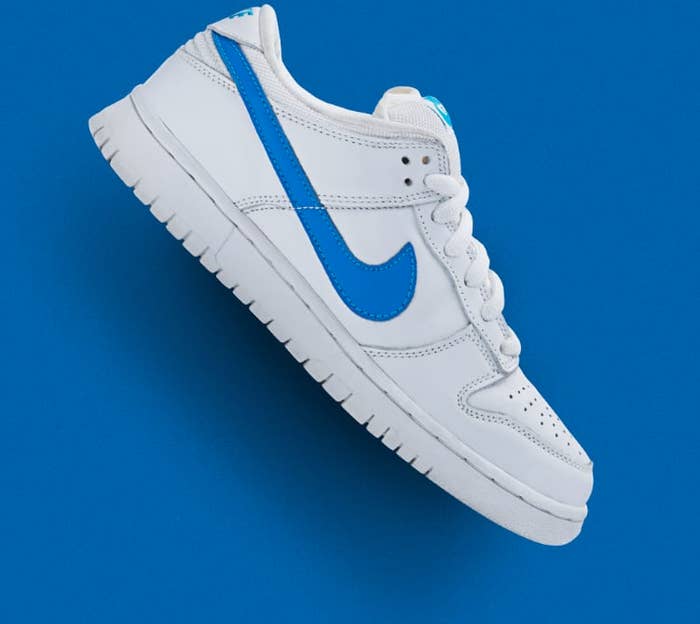
"Nike SB, in the beginning, it made shops hundreds of thousands of dollars. It was gold. A lot of people didn't know what they had. It gave a purpose to this new generation of sneaker culture," says Dom DeLuca, owner of Brooklyn Projects, a skate shop in Los Angeles that in 2002 was one of the first retailers to carry SB. "Especially when the Diamond Dunk dropped. They brought a whole new customer into the store of skate shops to buy shoes. It gave a reason for people to go to skate shops, other than buy a skateboard."
The "Diamond" Dunk, more often referred to as the “Tiffany” Dunk because of its colorway, was a collaboration between Diamond Supply Co. and Nike SB on a Dunk Low that was designed by the brand's owner, Nick "Diamond" Tershay, and released in 2005.
"I remember we got the Tiffanys in on a Friday. And I remember coming into work on Saturday morning and there was a big line. I remember sending the kid that was working for me downstairs to open the door and people just came upstairs, and, like, one by one, and the first kid was like, 'Do you have the Tiffanys?'" recalls Chris Rice, who was working at Eastern Border in New Hampshire and would go on to own Identity, a skate shop in Portsmouth, New Hampshire. "He's like, 'Do you have an 8? And I was like, "'Yeah, they're 150 bucks. And he's like, 'Yeah, no worries.' And I sold all of them in a row for 150 bucks. And from that point on, it was just money."

Selling the shoes for $150 in 2005 was significant. At the time, the box price of the sneakers was $65. For reference, a pair of retro Air Jordan Xs from 2005 retailed for $125. The practice of selling shoes for over retail seems unheard of in today's world of sneaker drops run only on Nike's SNKRS and a near-corporate conformity from retailers on every release, but it was quite common during the heyday of Nike SB in the 2000s. It was even a practice that Nike supported.
"I don't remember who the rep was at that time. It's just him just straight up telling us, "If it's a kid that's going to skate them, do box price. And if it's a sneakerhead, [make them pay extra]. And I was like, 'Oh, I love this. Like, this is awesome,'" says Rice.
DeLuca says that SB was "bonkers" between 2004 and 2006 in his shop. Rice said that clothes and sneakers made up about 75 percent of the business at Identity. One of the last releases that generated hype out of SB's "golden era" was the MF Doom Dunk High in 2007.
"I remember the first kid through the door and I was like, 'They're 250 bucks,' and no questions asked, paid. Maybe, like, the third or fourth kid in line was like, 'Dude, I shop here all the time,'" Rice recalls. "And I was like, 'Sick. I don't fucking care.' And the kid behind was like, 'I'll give you $300.' And the kid was like, 'I'll take them.' We sold, what, 10, 12 pairs of shoes in 20 minutes for $250 a piece, and the box price was $75."
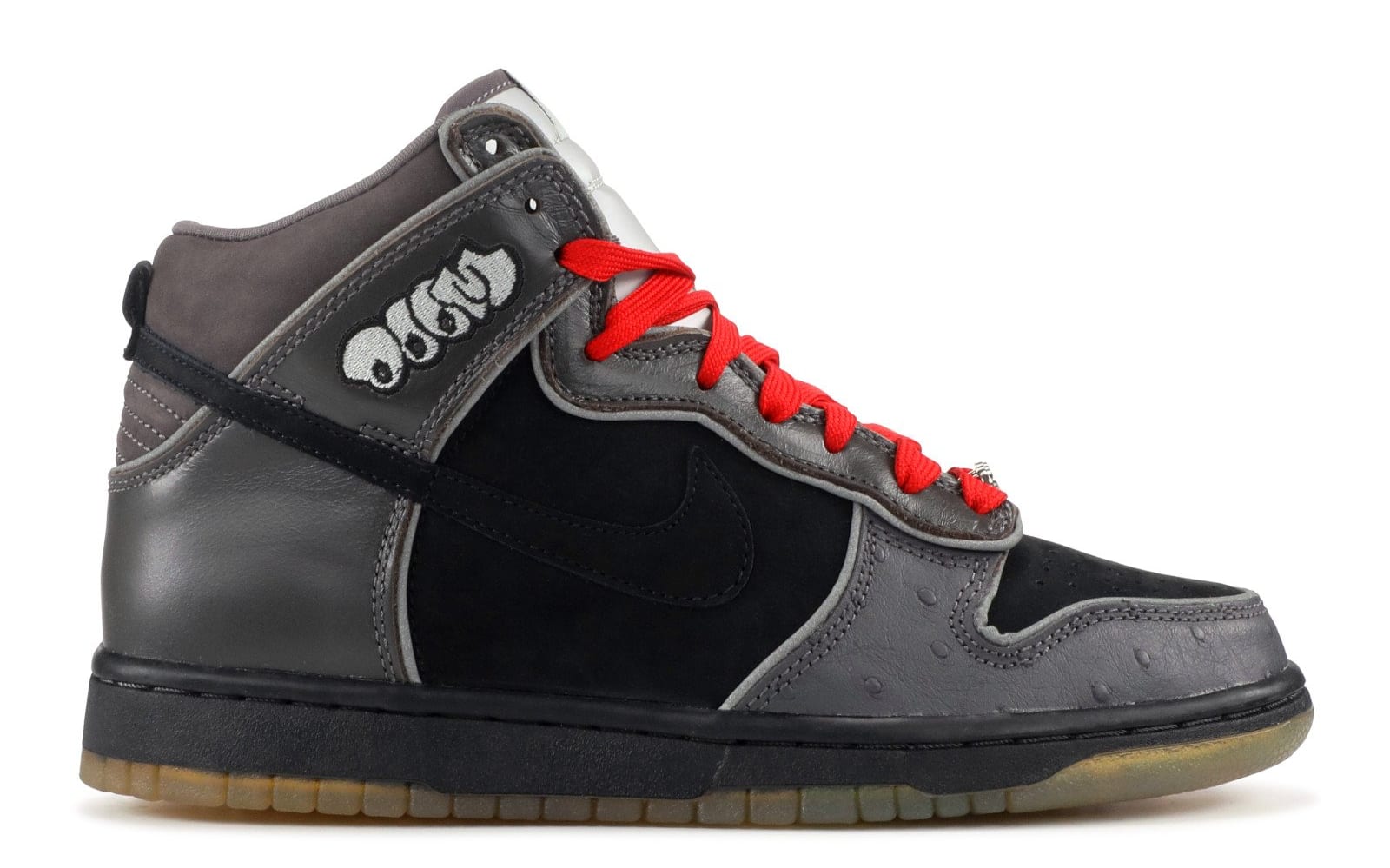
The good times with Nike SB wouldn't last forever. Seeing the line's success, Nike began to commercialize SB"—since they didn't commercialize the success itself. The brand launched a 6.0 line, which was a takedown collection of SB aimed at broader action sports and sold in mall retailers, and added new sneakers to the SB collection, which would go on to sell at stores such as PacSun. It was no longer just limited-edition Dunks (although there were other shoes that launched in the SB line early on) that were sold at neighborhood skate shops.
"They came out with 6.0, which diluted the SB skateboarding brand. It became more like an action sports thing. And then, also, the distribution in 2008, 2009, it just became so you can get SB everywhere," says DeLuca. "They were pumping out so much shit that stores had a hard time keeping up, because you had Dunks, you had Janoskis, you had E-Cues, you had Anguses, you had Blazers, all these silhouettes coming out. The hype wasn't there anymore because, at that time, then it was Jordan. By that time, 2011, 2012, nobody cared for SB."
The flooding of the shelves also put some skate shops in tough financial situations. While the Dunks were profitable, the other shoes weren’t. "You didn't get to choose what you wanted," says Philly Santosuosso, who now owns Humidity, a skate shop in New Orleans.
Even with Nike chasing profits off SB, the brand had a fair system of payment to keep the shops afloat and didn't seek to sink them over their past-due payments to the multibillion-dollar company.
"Everyone will say, 'Oh, if you don't pay your bill, [Nike's] going to go after your house and your family.’ But they were always cool. They were always understanding about late bills," says Rice. "You could only pay on a Nike website. You couldn't do it from a Mac. You had to do it from a PC. So you'd have to, like, go in the basement of the shop and pray that that PC fired up so you can pay Nike."
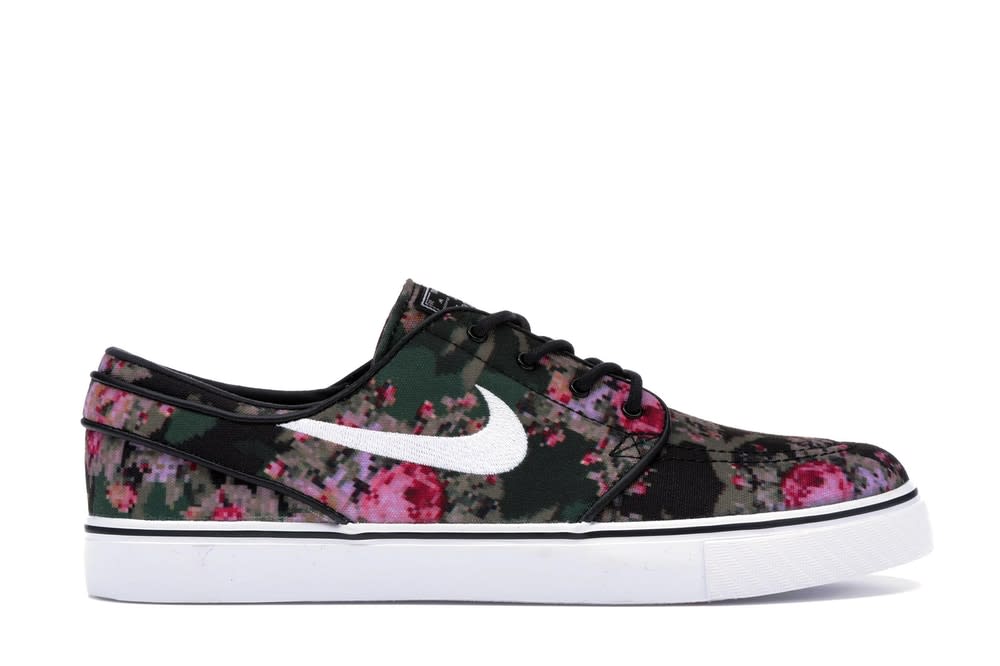
Rice also says the brand made him choose between selling SB and having an "energy" account, which afforded him access to different sneakers. The store was experimenting with different sneakers and growing. At one point, there was even a pair of Nike LeBron 7s in his store. But Identity eventually chose SB over “energy.”
All of this, coupled with the recession that hit in 2008 and a back-to-basics approach to dressing that saw utilitarian Vans and flannels gain popularity over bright sneakers and $200 Nike Dunks, was a recipe for disaster for skate shops and SB.
Rice closed Identity in 2013, saying it wasn't worth the effort anymore and his priorities, like starting a family, had shifted.
After years of blight, brightened by an occasional, SB started to gain momentum at ComplexCon in 2018, thanks to Diamond Supply Co. and the reworking of its Tiffany Dunk that saw pandemonium ensue. Releases from Jeff Staple, who added a new colorway to his Pigeon Dunk saga, and Concepts once again revisiting its Lobster Dunk theme injected some energy into SB.
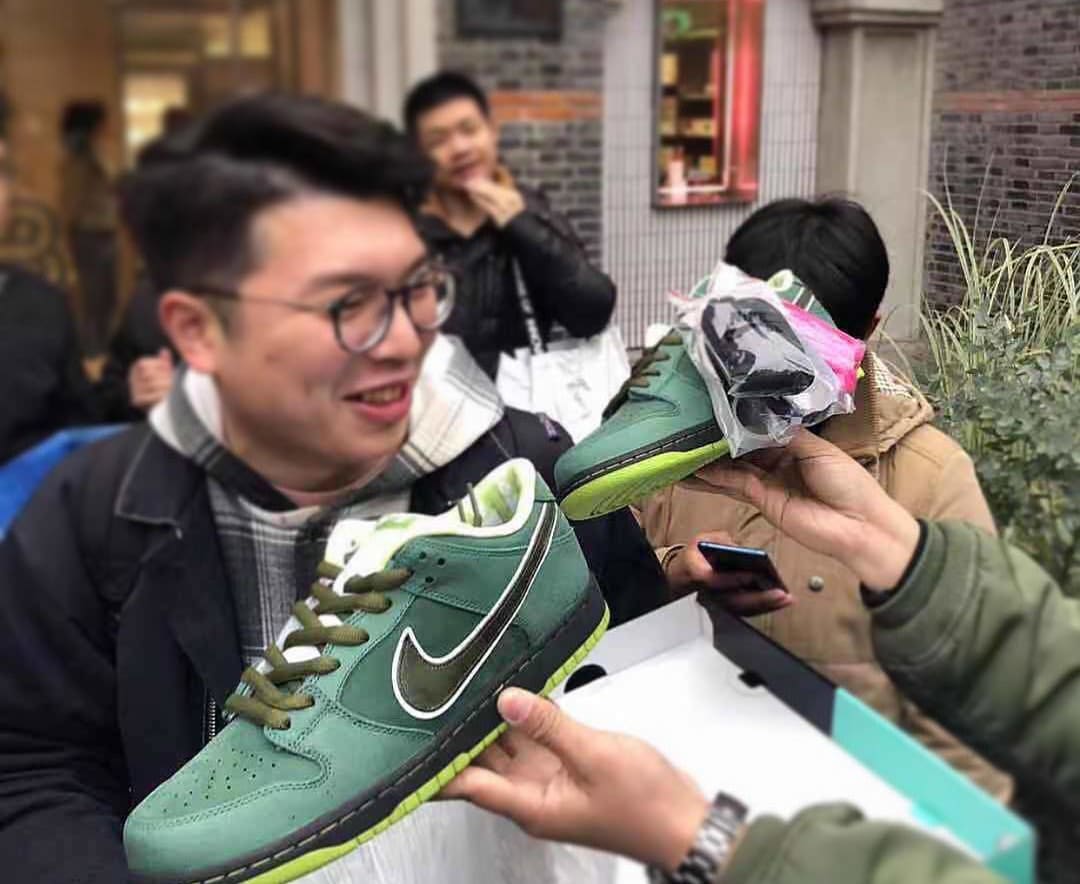
The biggest piece of the puzzle in reigniting Nike SB was its co-sign by Travis Scott. The rapper began wearing rare pairs from the past, which built even more buzz around the shoes. His childhood friend Chase B would help him hunt down old gems, with some help from his sneaker plug, Andre Ljustina, who owns Project Blitz in Los Angeles.
"Chase is really into them. When they were kids, they knew about all those shoes. They came in and started asking for a couple different Dunks," Ljustina told Complex in 2019. "They came in and started visiting my vault room, and they were like, 'Holy shit.' We had every single pair that was made. It became a process, and he wore them over time."
Travis wearing SBs not only brought energy to older pairs, but it also brought people into skate shops once again to try and buy the new releases. It didn't hurt that the brand was making shoes, like collaborations with Ben & Jerry's and the Grateful Dead, that people wanted again. This also would bring in all the madness that swirls around sneakers, too.
"You started getting your people back that were SB heads, and it also brought resellers," says Santosuosso. "We were still doing campouts at that time. And it became where the people camping out were just resellers. And that's when I was like, 'Yo, fuck this.' People that were genuinely sneaker heads are getting dicked over."
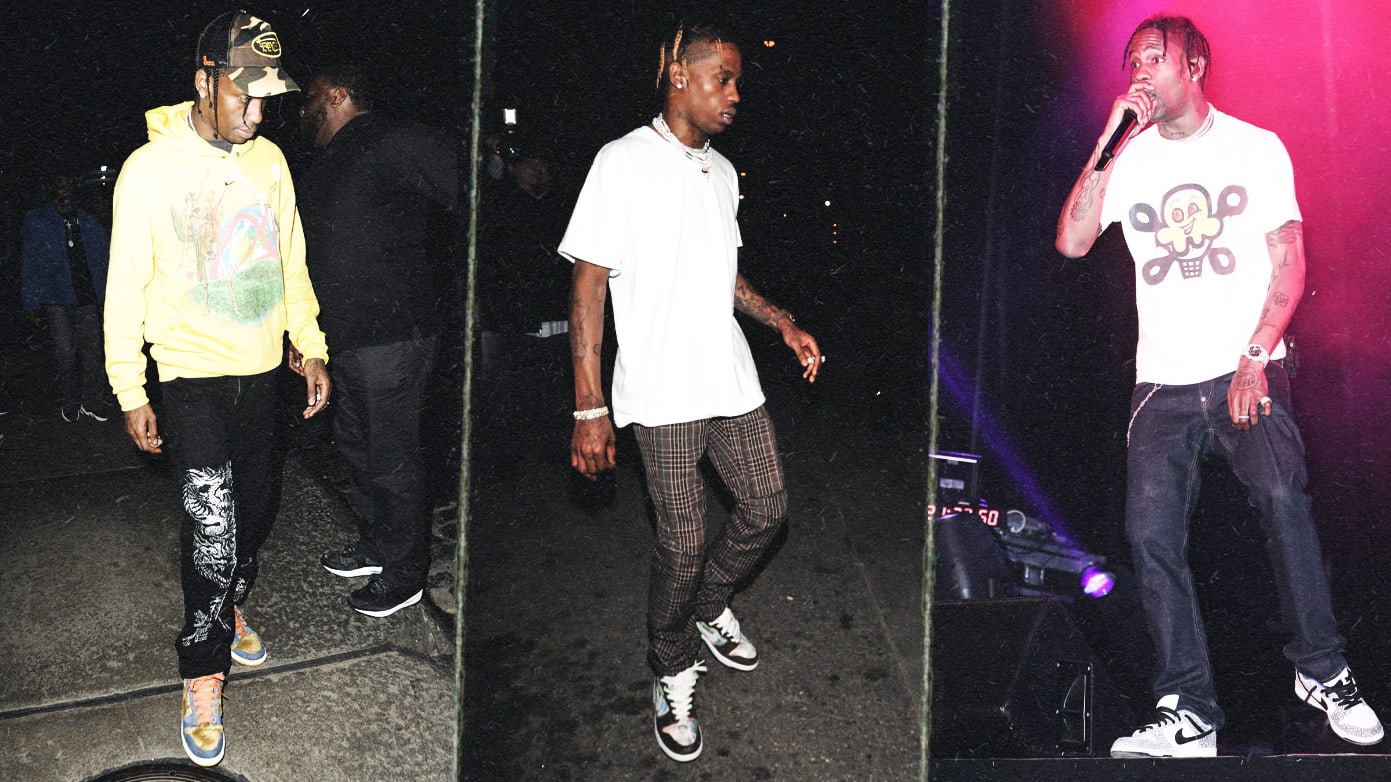
Not everyone is here for it, though, as some see Travis as someone who’s not authentically tied to skateboarding. "He never brought SB back; he just made it hype," says LaFlare. For people who was into sneakers and skated, he didn’t bring anything back. I’m not giving him that. He's the homie, but fuck out of here, sorry. I love Travis. Fuck with his music, everything he does. Just his little, 'I do skateboarding, too!' That shit wack. He was a kid; he was around. He liked Nike SBs and shit. But that fool doesn't know anything about skateboarding. He's just like, 'Oh, I saw this on a Tech Deck. Or Tony Hawk.'"
Violence even broke out in the new era of Nike SB. It was also alleged to be threatened at the Pigeon Dunk release in 2005, according to Staple and the New York Post. A lot of the blame gets placed on resellers, who want to profit off the shoes. "It's people that just want the quick flip. It's like, 'Oh, wow. I can just get these and fucking flip them for fucking 500 bucks.' Kids were getting robbed with the Diamond Dunk, that they would walk away with the shoes and get beat up and robbed a block away." says DeLuca. "After that, it was crazy. We did do lineups. We did have security. And after a couple of times, it was just fucked up. We liked doing the first come, first served, but people just don't know how to act accordingly."
DeLuca says his shop, because of the Travis Scott x Nike SB Dunk release, shifted to the raffle system, falling in line with how the rest of the sneaker boutique industry operates. But consumers weren't happy with that, either.
"We were so against raffling. Everybody was doing raffles. We didn't want to do it. But for this, Nike suggested, 'Hey, it's safe to do raffles. That's the easiest way. It's not the fairest way, but it's the easiest way,'" he says. "So then we started using the CopDate app. And then people had problems, had something to say about that—'Oh, raffles suck.'"

Brooklyn Projects then took phone orders, but that also drew ire from its consumers, so it's been difficult for the shop to find a process that makes everyone happy. The coronavirus lockdown has compounded that difficulty.
"You can't make these kids happy. What's the solution? You can't do first come, first served anymore because of the COVID. But besides that, it's not safe," says DeLuca. "Growing up, even in early 2000s, never had kids get robbed for fucking shoes. We sold the What the Dunk, which is the most valuable, coveted shoe next to the Tiffany Dunk, or the Heineken Dunk. We didn't have kids getting robbed. They waited in line. They bought the shoe. They went home, and that was it."
There's also a lot less of these hype Nike SB Dunks being produced, and allotted to skate shops, than the average consumer would think. Santosuosso says that customers don't understand that, at times, shops are only getting 12 to 24 pairs of shoes that hundreds of thousands of people want to buy. The stock doesn't compare to a mass market Yeezy or Air Jordan in the slightest, and that can be hard to convey to the consumer.
“I'm getting a lot of the heat, like are dudes literally cursing me out and shit, and it's because they're used to [stores having a 100 pairs],” says Santosuosso. “I’m like, ‘We only got 20 pairs.’ People are used to Jordans. Even if they can’t get them in one store, every story in the country will have them. People assume we get [that many pairs of SBs, too.] And I’m like, ‘Nah, I’ll show you the invoice. We got 15 pairs.’ That’s the biggest frustration.”
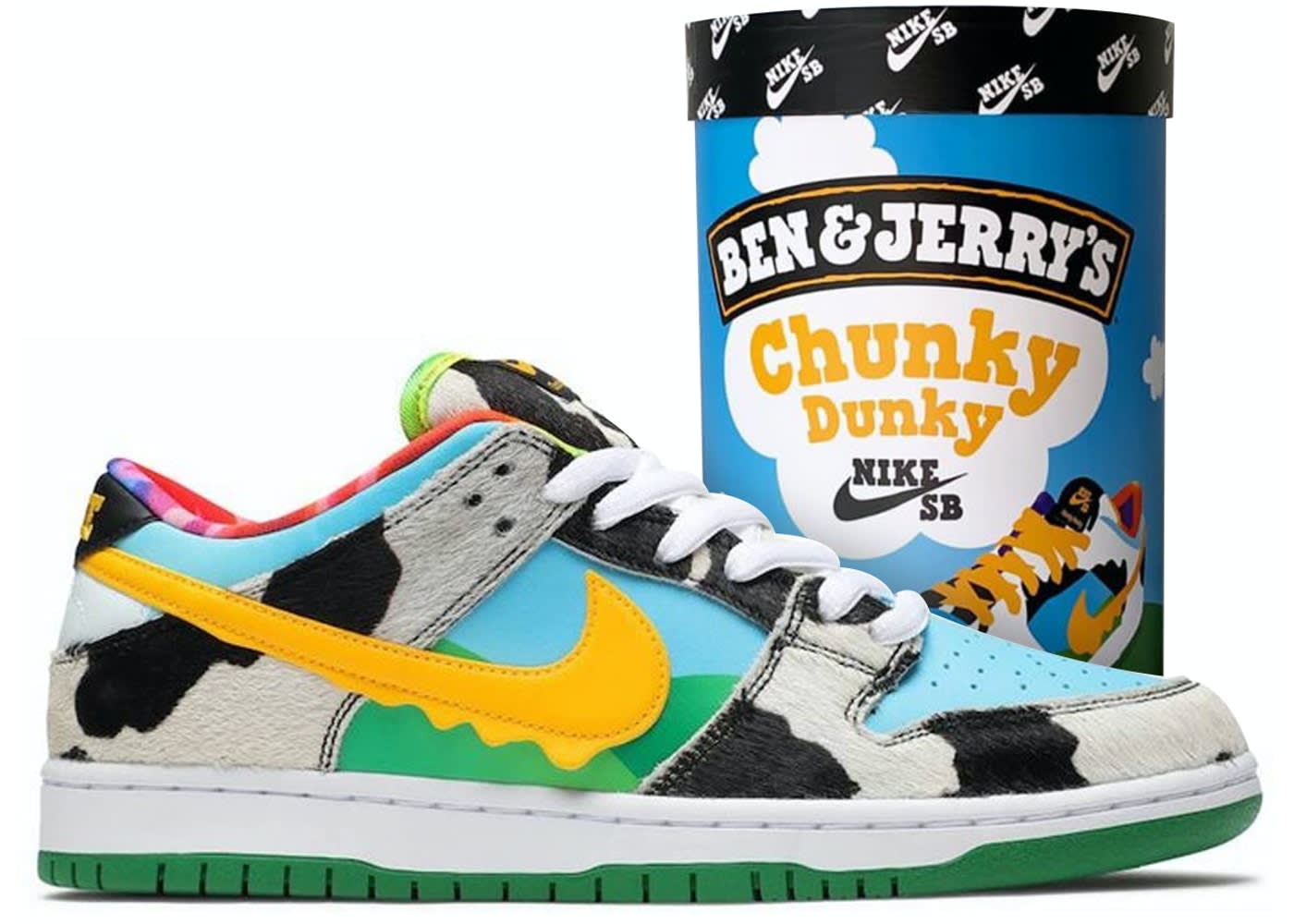
Through all of it, though, skate shop owners can't be mad that there's a renewed interest in Nike SB and the stuff that they're selling. It's money in the register during a hard time for everyone and a newfound relevance among a new type of consumer
"I'm definitely, like, not one of those shop owners that was bummed on it. I'll take it," says Santosuosso. "I see these shop owners being like, 'Fuck this,’ or 'Fuck that.' I'm like, 'Well, yo, let me get your pairs. I'll deal with it.'"
DeLuca agrees that all of the hype around SB has been positive for skate shops, and he sees Nike as helping shops right now, too.
"Nike SB, they've definitely put skateboard shops back on the map," he says. "They're really trying to help skateboard shops. Travis Scott, he was really one of the first to give it back to the skateboard shops. When he did that Dunk, he wanted it to be a skateboard shops first. He did give it a boost of energy."
Nearly two decades after its launch, Nike SB is in a new place, which is similar to its old place, for those who remember. The brand partners may be bigger, the people searching for the shoes may be moms who love ice cream, but the messaging is all the same: Here are some funky shoes that are too absurd to exist anywhere else but in skate shops. And it works.
It might be a new crop of people buying the shoes, and those who used to sell them might be in different places in their lives, but a lot of the energy and feeling is the same.
"I had a conversation yesterday with a random dad that I brought my kids over to hang out with. We were kind of shooting the shit and he's like, 'You see those Grateful Dead Dunks?'" Rice says. "And I was like, 'Yeah, they're kinda horrible.' And he says, 'I got a pair and sold them for $1,400 bucks.' And I was like, 'That's awesome.'"

